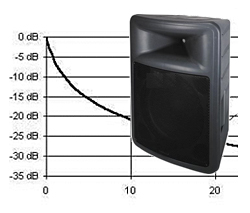The main effect of damping in a loudspeaker is to reduce the SPL produced by the loudspeaker’s diaphragm moving because of its own inertia after the signal stops.
The frequency of the sound it produces with this movement will be at the resonant frequency of the moving system.
A common term for this is “overhang”. In severe cases this can translate into “one note bass”.
Types Of Loudspeaker Damping
There are two types of loudspeaker damping: mechanical and electrical. The loudspeaker’s suspension and the air load on the diaphragm determines the amount of mechanical damping. This cannot be determined except by sophisticated measurements.
Electrical damping is determined by the resistance load on the loudspeaker, which is the sum of the loudspeaker cable resistance and the amplifier output impedance. This can be determined by a simple calculation.
Electrical damping or Damping Factor (DF) is calculated by dividing the loudspeaker’s voice coil DC resistance by the sum of the loudspeaker cable resistance and amplifier output impedance.
Attenuating “Overhang”
The amount of attenuation that electrical damping provides is:
DF10 = -20 dB, DF20 = -26 dB, DF50 = -33 dB.
This is added to the loudspeakers mechanical damping. Because of this addition, an electrical damping factor of 20 or more is considered adequate for live sound reinforcement systems.
With an electrical DF of 20 or more, the SPL produced by the loudspeaker moving on its own inertia will be essentially inaudible. The following chart shows the effect of electrical damping on the attenuation of the sound generated by the loudspeaker after the signal stops.

Driver Variations
The larger the driver the more import electrical damping is. Low frequency drivers and subwoofers have the most problems regarding damping. Their moving mass is quite high and their suspensions are comparatively weak compared to this mass.
Because of this, they have relatively poor mechanical damping and therefore electrical damping is important. High frequency drivers have much lighter mass and stiff suspensions compared to that mass. As a result electrical damping is relatively unimportant.















